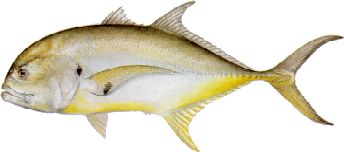| FISH |
IMAGE |
Description: |
Where found: |
FLORIDA RECORD: |
| Redfish |
 |
chin without barbels; copper bronze body, lighter shade in clear waters; one to many spots at base of tail (rarely no spots); mouth horizontal and opening downward; scales large. |
juveniles are an INSHORE fish, migrating out of the estuaries at about 30 inches (4 years) and joining the spawning population OFFSHORE. |
|
| Tarpon |
 |
last ray of dorsal fin extended into long filament; one dorsal fin; back dark blue to green or greenish black, shading into bright silver on the sides; may be brownish gold in estuarien waters; huge scales; mouth large and points upward. |
primarily INSHORE fish, although adult fish spawn OFFSHORE where the ribbon-like larval stage of the fish can be found. |
243 lbs. |
| Baby Tarpon |
 |
|
They live close to their food source until they mature enough to venture out into the open waters. Baby tarpon are often found in canals, along the edges of mangrove shorelines and under bridges |
|
| Spanish Mackerel |
 |
color of back green, shading to silver on sides, golden yellow irregular spots above and below lateral line; front of dorsal fin black; lateral line curves gently to base of tail. |
INSHORE, NEARSHORE and OFFSHORE, especially over grass beds and reefs; absent from north Florida waters in winter. |
12 lbs. |
| Ladyfish |
 |
terminal mouth, slender body, small scales; last dorsal ray not elongated; head small and pointed. |
INSHORE fish, in bays and estuaries; occasionally enters freshwater, occurring in tidal pools and canals; often forms large schools and harasses bait at the surface. |
4 lbs., 10 ozs. |
| BlueFish |
 |
color blue or greenish blue on back, sides silvery; mouth large; teeth prominent, sharp, and compressed; dorsal and anal fins nearly the same size; scales small; lateral line almost straight. |
young usually INSHORE spring and summer, moving OFFSHORE to join adults fall and winter; strong migration of northeast Atlantic stock to Florida east coast in winter. |
22 lbs., 3 ozs. |
| Crevall Jack |
 |
color bluish-green to greenish-gold back and silvery or yellowish belly; soft dorsal and anal fins almost identical in size; prominent black spot on operculum (gill cover); black spot at the base of each pectoral fin; no scales on throat. |
common in both INSHORE waters and the open sea. |
51 lbs. |
| Cobia |
 |
long, slim fish with broad depressed head; lower jaw projects past upper jaw; dark lateral stripe extends through eye to tail; first dorsal fin comprised of 7 to 9 free spines; when young, has conspicuous alternating black and white horizontal stripe |
both INSHORE and NEARSHORE inhabiting inlets, bays, and among mangroves; frequently seen around bouys, pilings, and wrecks. |
103 lbs., 12 ozs. |
| Permit |
 |
color gray, dark or iridescent blue above, shading to silvery sides, in dark waters showing golden tints around breast; small permit have teeth on tongue (none on pompano); no scutes; dorsal fin insertion directly above that of the anal fin; 17 to 21 soft anal rays. |
OFFSHORE on wrecks and debris, INSHORE on grass flats, sand flats, and in channels; most abundant in south Florida, with smaller specimens from every coastal county. |
51 lbs., 8 ozs. |
| Sea Trout |
 |
pale body color, yellow above, silver to white below; one or two prominent canine teeth usually at tip of upper jaw; inside of mouth yellow; no well-defined black spots on back; 10 to 12 soft rays in anal fin; no chin barbels. |
a Gulf species that may occur in the Atlantic waters of extreme south-eastern Florida; adults predominantly found INSHORE residing in bays and inlets but may move OFFSHORE during winter months; young occur INSHORE in shallow bays. |
n/a |
| Snook |
 |
distinct lateral line; high, divided dorsal fin; sloping forehead; large mouth, protruding lower jaw; grows much larger than other snooks; pelvic fin yellow |
from central Florida south, usually INSHORE in coastal and brackish waters, along mangrove shorelines, seawalls, and bridges; also on reefs and pilings NEARSHORE. |
44 lbs., 3 ozs. |